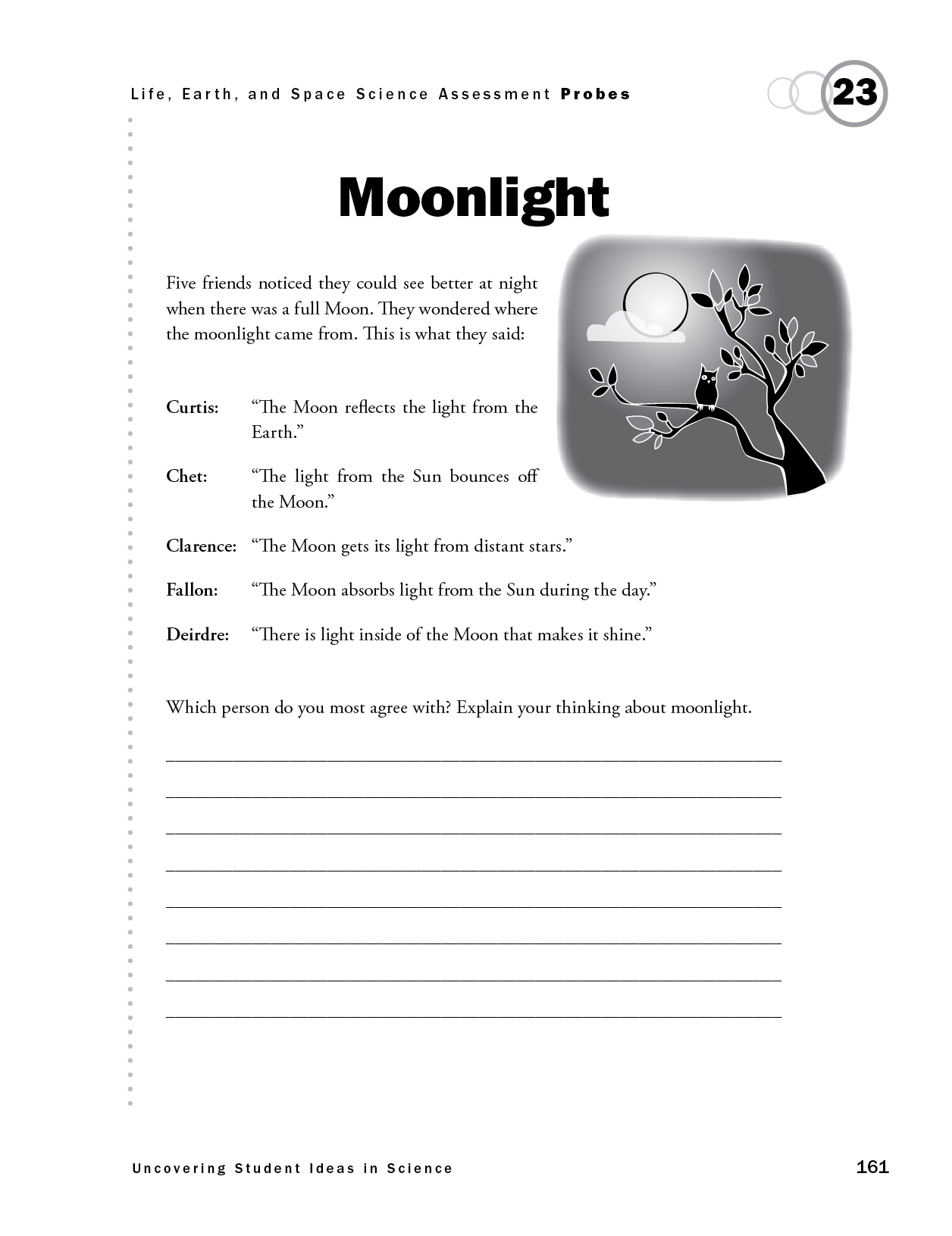Elementary | Formative Assessment Probe
Moonlight
By Page Keeley
Assessment Earth & Space Science Elementary Grade 5
Sensemaking Checklist




This is the new updated edition of the first book in the bestselling Uncovering Student Ideas in Science series. Like the first edition of volume 1, this book helps pinpoint what your students know (or think they know) so you can monitor their learning and adjust your teaching accordingly. Loaded with classroom-friendly features you can use immediately, the book includes 25 “probes”—brief, easily administered formative assessments designed to understand your students’ thinking about 60 core science concepts.

Purpose
The purpose of this assessment probe is to elicit students’ ideas about light and the Moon. The probe is designed to find out what students think is the source of a full Moon’s light.
Type of Probe
Friendly Talk
Related Concepts
light reflection, Moon, Moon phases
Explanation
The best answer is Chet’s: “The light from the Sun bounces off the Moon.” In other words, the Moon reflects sunlight. Even though you do not see the Sun in the evening, it does shine on the surface of the Moon. The light from the Sun reflects off the Moon and travels to Earth. Therefore, during a full Moon, the moonlight that helps us see better during the evening after the Sun has set is actually sunlight that is bouncing off the Moon, striking the Earth, reflecting off objects, and entering our eyes, which allows us to see things at night. When there is no full Moon, there is less light reaching and reflecting off the Earth; therefore, we see better when there is a full Moon. In contrast, stars emit their own light. They are sources of light rather than objects that reflect light.
Curricular and Instructional Considerations
Elementary Students
In the elementary grades, students observe different phases of the Moon over time and describe the monthly pattern. They should also be challenged to think about why we can see the Moon, developing the idea that light from the Sun is reflected by the Moon toward Earth. Reflection of light is a prerequisite understanding that should be developed before students learn that the Moon reflects light.
Middle School Students
In the middle grades, students develop a more sophisticated understanding of light reflection and the phases of the Moon. Now is the time when they can begin putting together ideas about the Earth, Moon, and Sun system to construct an understanding of what causes the phases of the Moon. By middle school, they should be able to distinguish between stars that give off their own light versus Moons and planets that can be seen by the Sun’s reflected light.
High School Students
By high school, students should understand that the light from the Moon comes from reflected sunlight. However, there may be some students who still hold on to early misconceptions that were never challenged.
Administering the Probe
Make sure students understand the context of this probe. Students in urban areas may have never experienced the difference in nighttime darkness during the light of a full Moon.
Related Research
- Understanding the phases of the Moon is very challenging for students. To understand the phases of the Moon they must first master the idea of a spherical Earth and understand the concept of light reflection and how the Moon gets its light from the Sun (AAAS 1993).
Related NSTA Resources
Ansberry, K., and E. Morgan. 2008. Teaching through trade books: Moon phases and models. Science & Children (Sept.): 20–22.
Gilbert, S., and S. Ireton. 2003. Understanding models in Earth and space science. Arlington, VA: NSTA Press.
Young, T., and M. Guy. 2008. The Moon’s phases and the self shadow. Science & Children (Sept.): 30–35.
Suggestions for Instruction and Assessment
- Compare and contrast objects that emit their own light and objects that reflect light, and connect this to how we see the Moon.
- For students who believe the Moon creates its own light, use a model to confront them with their ideas. Shine a light on a white Styrofoam ball in a dark room. Have students describe what they see. Ask them to examine the ball to decide if there is something in it that caused it to light up. Give students time to revise their explanation after experiencing the model.
- Model the relationship between the Moon and the Sun at night. Using a model, show how the Sun shines on the Moon, even though we do not see the Sun during the night.


